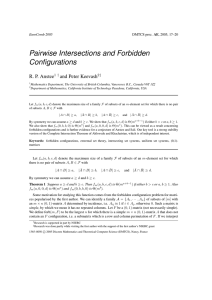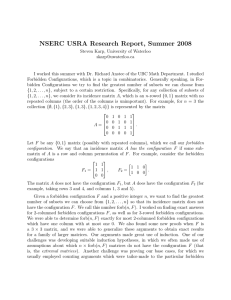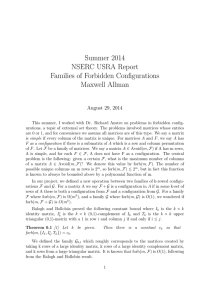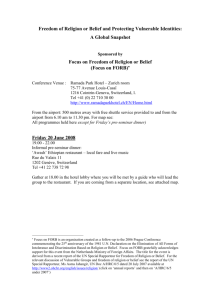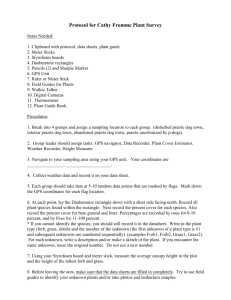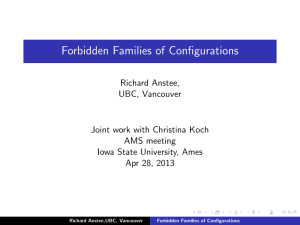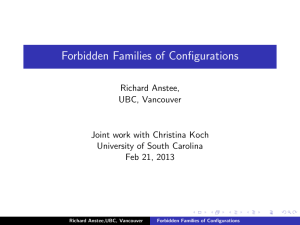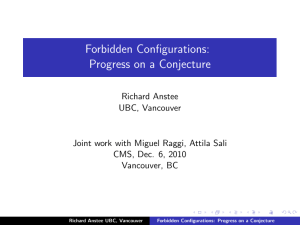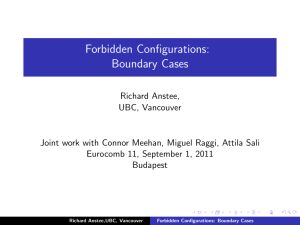Forbidden Configurations and Repeated Induction Summer 2010 — NSERC USRA Report
advertisement
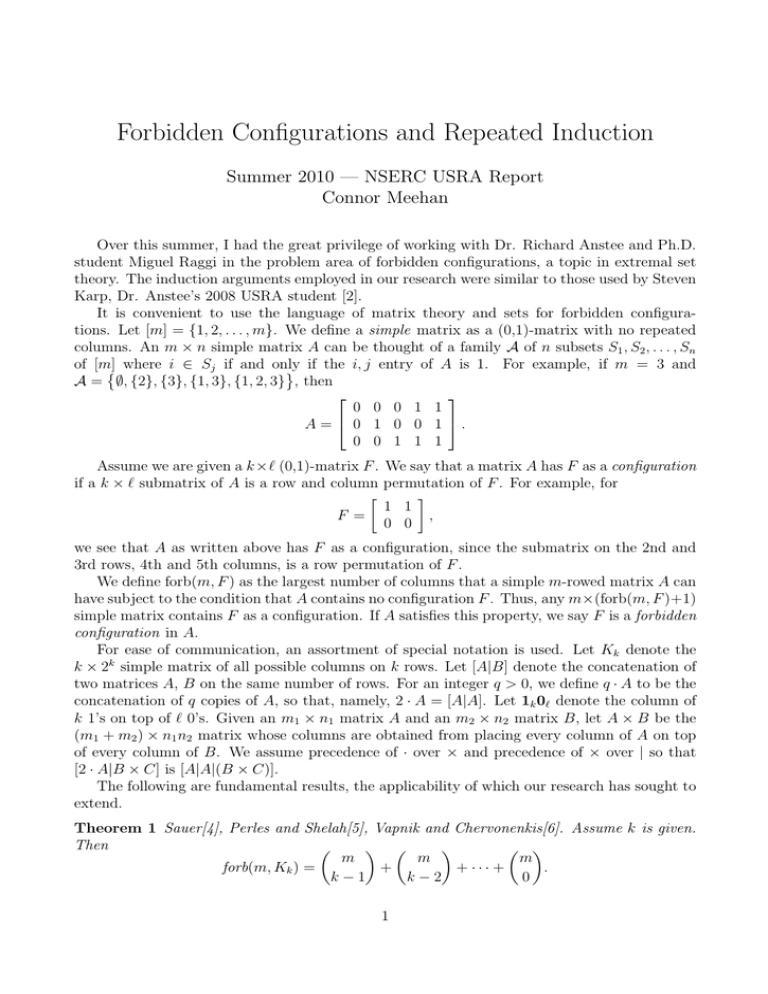
Forbidden Configurations and Repeated Induction
Summer 2010 — NSERC USRA Report
Connor Meehan
Over this summer, I had the great privilege of working with Dr. Richard Anstee and Ph.D.
student Miguel Raggi in the problem area of forbidden configurations, a topic in extremal set
theory. The induction arguments employed in our research were similar to those used by Steven
Karp, Dr. Anstee’s 2008 USRA student [2].
It is convenient to use the language of matrix theory and sets for forbidden configurations. Let [m] = {1, 2, . . . , m}. We define a simple matrix as a (0,1)-matrix with no repeated
columns. An m × n simple matrix A can be thought of a family A of n subsets S1 , S2 , . . . , Sn
of [m]
where i ∈ Sj if and only
if the i, j entry of A is 1. For example, if m = 3 and
A = ∅, {2}, {3}, {1, 3}, {1, 2, 3} , then
0 0 0 1 1
A = 0 1 0 0 1 .
0 0 1 1 1
Assume we are given a k ×` (0,1)-matrix F . We say that a matrix A has F as a configuration
if a k × ` submatrix of A is a row and column permutation of F . For example, for
1 1
F =
,
0 0
we see that A as written above has F as a configuration, since the submatrix on the 2nd and
3rd rows, 4th and 5th columns, is a row permutation of F .
We define forb(m, F ) as the largest number of columns that a simple m-rowed matrix A can
have subject to the condition that A contains no configuration F . Thus, any m×(forb(m, F )+1)
simple matrix contains F as a configuration. If A satisfies this property, we say F is a forbidden
configuration in A.
For ease of communication, an assortment of special notation is used. Let Kk denote the
k × 2k simple matrix of all possible columns on k rows. Let [A|B] denote the concatenation of
two matrices A, B on the same number of rows. For an integer q > 0, we define q · A to be the
concatenation of q copies of A, so that, namely, 2 · A = [A|A]. Let 1k 0` denote the column of
k 1’s on top of ` 0’s. Given an m1 × n1 matrix A and an m2 × n2 matrix B, let A × B be the
(m1 + m2 ) × n1 n2 matrix whose columns are obtained from placing every column of A on top
of every column of B. We assume precedence of · over × and precedence of × over | so that
[2 · A|B × C] is [A|A|(B × C)].
The following are fundamental results, the applicability of which our research has sought to
extend.
Theorem 1 Sauer[4], Perles and Shelah[5], Vapnik and Chervonenkis[6]. Assume k is given.
Then
m
m
m
forb(m, Kk ) =
+
+ ··· +
.
k−1
k−2
0
1
Theorem 2 Gronau[3]. forb(m, 2 · Kk ) = forb(m, Kk+1 ).
We have been able to augment these theorems by proving that these bounds hold for larger
versions of these matrices. Some results of our research are below. Many of the new results
come from repeated use of induction arguments that have been common in previous forbidden
configurations research.
Theorem 3 Let k ≥ 4 be a given integer. Let α be a k × 1 (0,1)-column consisting of at least
two 1’s and at least two 0’s. For m ≥ k + 1,
m
m
m
forb(m, [Kk |α]) = forb(m, Kk ) =
+
+ ··· +
.
k−1
k−2
0
In fact, we can add more than one column.
Theorem 4 Let p, q, k be given with p, q ≥ 2 and k > p + q. Assume p+q
≥ k + 2. Then for
p
m
m
m ≥ k + 1, forb(m, [Kk |1p 0q × Kk−p−q ]) = forb(m, Kk ) = k−1 + k−2 + · · · + m0 . Moreover,
for 4 ≤ k ≤ 14 and m ≥ k + 1, forb(m, [Kk |12 02 × Kk−4 ]) = forb(m, Kk ).
We expect that the result holds for more choices on p, q and our proof for the case p = q = 2
indicates some of the arguments that may help to show this.
When considering the matrix 2 · Kk , the use of Theorem 2 makes arguments for induction
base cases simpler, allowing an easier proof for a larger matrix extension. Let
1 0 1 0
F1 = 0 1 1 1 .
0 0 0 1
Theorem 5 For m ≥ k + 2, forb(m, [2 · Kk |F1 × Kk−3 ]) = forb(m, 2 · Kk ).
We also considered the problem of constructing a matrix such that every k-set of rows has
a k-rowed configuration F , which is in some ways a polar opposite problem. Specifically, we
define req(m, F ), for a k-rowed (0,1)-matrix F , as the minimum number of columns that an
m-rowed simple matrix A can have (m ≥ k) such that A contains F as a configuration on every
k-set of rows. The following result can be obtained via a construction.
Theorem 6 Let k be given.
req(m, Kk ) = O (log m)k−1 .
Dr. Anstee, Miguel Raggi, and I have drafted a paper that includes these results. As it
stands now, it seems that we have far from exhausted the potential of these methods and that
much more could be proved. In particular, there are likely more examples of matrices G and
H such that forb(m, [Kk |G]) = forb(m, Kk ) and forb(m, [2 · Kk |H]) = forb(m, 2 · Kk ). For more
information on forbidden configurations, consult Dr. Anstee’s survey paper [1].
2
References
[1] R.P. Anstee, A Survey of Forbidden Configurations results,
http://www.math.ubc.ca/∼ anstee.
[2] R.P. Anstee and S.N. Karp, Forbidden Configurations: Exact bounds determined by critical
substructures, Elec. J. of Combin. 17(2010), R50, 27pp.
[3] H.O.F. Gronau, An extremal set problem, Studia Sci. Math. Hungar. 15(1980), 29-30.
[4] N. Sauer, On the density of families of sets, J. Combin. Th. Ser. A 13(1972), 145-147.
[5] S. Shelah, A combinatorial problem: Stability and order for models and theories in infinitary
languages, Pac. J. Math. 4(1972), 247-261.
[6] V.N. Vapnik and A.Ya. Chervonenkis, On the uniform convergence of relative frequencies
of events to their probabilities, Th. Prob. and Applics. 16(1971), 264-280.
3
